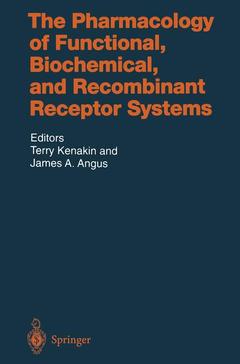Description
The Pharmacology of Functional, Biochemical, and Recombinant Receptor Systems, Softcover reprint of the original 1st ed. 2000
Coll. Handbook of Experimental Pharmacology, Vol. 148
Coordinators: Kenakin T., Angus J. A.
Language: French
Subjects for The Pharmacology of Functional, Biochemical, and...:
The Pharmacology of Functional, Biochemical, and Recombinant Receptor Systems
Publication date: 10-2012
448 p. · 15.5x23.5 cm · Paperback
Publication date: 10-2012
448 p. · 15.5x23.5 cm · Paperback
Pharmacology of functional, biochemical & recombinant receptor systems (Handbook of experimental pharmacology 148)
Publication date: 07-2000
530 p. · 23.5x15.9 cm · Hardback
Publication date: 07-2000
530 p. · 23.5x15.9 cm · Hardback
Description
/li>Contents
/li>Comment
/li>
This, the 148th volume of the Handbook of Experimental Pharmacology series, focuses on the very core of pharmacology, namely receptor theory. It is fitting that the originator of receptor pharmacology, A. J. CLARK, authored the fourth volume of this series 63 years ago. In that volume CLARK further developed his version of receptor theory first described four years earlier in his classic book The Mode of Action of Drugs. An examination of the topics covered in volume 4 reveals a striking similarity to the topics covered in this present volume; pharmacologists today are still as interested in unlocking the secrets of dose-response relationships to reveal the biological and che mical basis of drug action as they were over half a century ago. Sections in that 1937 volume such as "Curves relating exposure to drugs with biological effects" and "Implications of monomolecular theory" show Clark's keen insight into the essential questions that required answers to move pharma cology forward. With the advent of molecular biological cloning of human receptors has come a transformation of receptor pharmacology. Thus the expression of human receptors into surrogate host cells helped unlock secrets of receptor mechanisms and stimulus-transduction pathways. To a large extent, this elim inates the leap of faith required to apply receptor activity of drugs tested on animal receptor systems to the human therapeutic arena. However, a new leap of faith concerning the veracity of the effects found in recombinant systems with respect to natural ones is now required.
Introduction: Bioassays — Past Uses and Future Potential.- Section I: Classical Pharmacology and Isolated Tissue Systems.- 1 Human Vascular Receptors in Disease: Pharmacodynamic Analyses in Isolated Tissue.- 2 Problems in Assigning Mechanisms: Reconciling the Molecular and Functional Pathways in ?-Adrenoceptor-Mediated Vasoconstriction.- 3 Gs Protein-Coupled Receptors in Human Heart.- Section II: New Theoretical Concepts and Molecular Mechanisms of Receptor Function.- 4 Kinetic Modeling Approaches to Understanding Ligand Efficacy.- 5 The Evolution of Drug-Receptor Models: The Cubic Ternary-Complex Model for G Protein-Coupled Receptors.- 6 Inverse Agonism.- 7 Efficacy: Molecular Mechanisms and Operational Methods of Measurement. A New Algorithm for the Prediction of Side Effects.- 8 A Look at Receptor Efficacy. From the Signalling Network of the Cell to the Intramolecular Motion of the Receptor.- 9 Mechanisms of Non-Competitive Antagonism and Co-Agonism.- 10 Mechanisms of Receptor Activation and the Relationship to Receptor Structure.- Section III: New Technologies for the Study of Drug Receptor Interaction.- 11 The Assembly of Recombinant Signalling Systems and Their Use in Investigating Signaling Dynamics.- 12 Insect Cell Systems to Study the Communication of Mammalian Receptors and G Proteins.- 13 Altering the Relative Stoichiometry of Receptors, G Proteins and Effectors: Effects on Agonist Function.- 14 The Study of Drug-Receptor Interaction Using Reporter Gene Systems in Mammalian Cells.- 15 Melanophore Recombinant Receptor Systems.
Includes supplementary material: sn.pub/extras
© 2024 LAVOISIER S.A.S.




